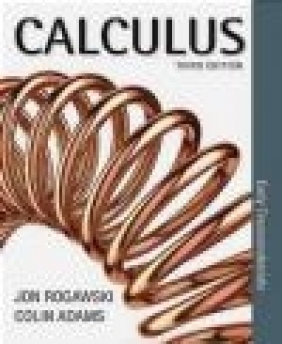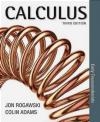Calculus: Early Transcendentals
Colin Adams, Jon Rogawski
Calculus: Early Transcendentals
Colin Adams, Jon Rogawski
- Producent: Freeman WH
- Rok produkcji: 2015
- ISBN: 9781464114885
- Ilość stron: 1050
- Oprawa: Twarda
Niedostępna
Opis: Calculus: Early Transcendentals - Colin Adams, Jon Rogawski
The most successful calculus book of its generation, Jon Rogawski s "Calculus" offers an ideal balance of formal precision and dedicated conceptual focus, helping students build strong computational skills while continually reinforcing the relevance of calculus to their future studies and their lives.Guided by new author Colin Adams, the new edition stays true to the late Jon Rogawski s refreshing and highly effective approach, while drawing on extensive instructor and student feedback, and Adams three decades as a calculus teacher and author of math books for general audiences.W. H. Freeman/Macmillan and WebAssign have partnered to deliver WebAssign "Premium" a comprehensive and flexible suite of resources for your calculus course. Combining the most widely used online homework platform with the authoritative and interactive content from the textbook, WebAssign "Premium" extends and enhances the classroom experience for instructors and students."Rogawski/Adams: Calculus Early Transcendentals 3e Table of Contents Chapter 1: Precalculus Review 1.1 Real Numbers, Functions, and Graphs 1.2 Linear and Quadratic Functions 1.3 The Basic Classes of Functions 1.4 Trigonometric Functions 1.5 Inverse Functions 1.6 Exponential and Logarithmic Functions 1.7 Technology: Calculators and Computers Chapter Review Exercises Chapter 2: Limits 2.1 Limits, Rates of Change, and Tangent Lines 2.2 Limits: A Numerical and Graphical Approach 2.3 Basic Limit Laws 2.4 Limits and Continuity 2.5 Evaluating Limits Algebraically 2.6 Trigonometric Limits 2.7 Limits at Infinity 2.8 Intermediate Value Theorem 2.9 The Formal Definition of a Limit Chapter Review Exercises Chapter 3: Differentiation 3.1 Definition of the Derivative 3.2 The Derivative as a Function 3.3 Product and Quotient Rules 3.4 Rates of Change 3.5 Higher Derivatives 3.6 Trigonometric Functions 3.7 The Chain Rule 3.8 Implicit Differentiation 3.9 Derivatives of General Exponential and Logarithmic Functions 3.10 Related Rates Chapter Review Exercises Chapter 4: Applications of the Derivative 4.1 Linear Approximation and Applications 4.2 Extreme Values 4.3 The Mean Value Theorem and Monotonicity 4.4 The Shape of a Graph 4.5 L'Hopital's Rule 4.6 Graph Sketching and Asymptotes 4.7 Applied Optimization 4.8 Newton's Method Chapter Review Exercises Chapter 5: The Integral 5.1 Approximating and Computing Area 5.2 The Definite Integral 5.3 The Indefinite Integral 5.4 The Fundamental Theorem of Calculus, Part I 5.5 The Fundamental Theorem of Calculus, Part II 5.6 Net Change as the Integral of a Rate 5.7 Substitution Method 5.8 Further Transcendental Functions 5.9 Exponential Growth and Decay Chapter Review Exercises Chapter 6: Applications of the Integral 6.1 Area Between Two Curves 6.2 Setting Up Integrals: Volume, Density, Average Value 6.3 Volumes of Revolution 6.4 The Method of Cylindrical Shells 6.5 Work and Energy Chapter Review Exercises Chapter 7: Techniques of Integration 7.1 Integration by Parts 7.2 Trigonometric Integrals 7.3 Trigonometric Substitution 7.4 Integrals Involving Hyperbolic and Inverse Hyperbolic Functions 7.5 The Method of Partial Fractions 7.6 Strategies for Integration 7.7 Improper Integrals 7.8 Probability and Integration 7.9 Numerical Integration Chapter Review Exercises Chapter 8: Further Applications of the Integral and Taylor Polynomials 8.1 Arc Length and Surface Area 8.2 Fluid Pressure and Force 8.3 Center of Mass 8.4 Taylor Polynomials Chapter Review Exercises Chapter 9: Introduction to Differential Equations 9.1 Solving Differential Equations 9.2 Models Involving y^'=k(y-b) 9.3 Graphical and Numerical Methods 9.4 The Logistic Equation 9.5 First-Order Linear Equations Chapter Review Exercises Chapter 10: Infinite Series 10.1 Sequences 10.2 Summing an Infinite Series 10.3 Convergence of Series with Positive Terms 10.4 Absolute and Conditional Convergence 10.5 The Ratio and Root Tests 10.6 Power Series 10.7 Taylor Series Chapter Review Exercises Chapter 11: Parametric Equations, Polar Coordinates, and Conic Sections 11.1 Parametric Equations 11.2 Arc Length and Speed 11.3 Polar Coordinates 11.4 Area and Arc Length in Polar Coordinates 11.5 Conic Sections Chapter Review Exercises Chapter 12: Vector Geometry 12.1 Vectors in the Plane 12.2 Vectors in Three Dimensions 12.3 Dot Product and the Angle Between Two Vectors 12.4 The Cross Product 12.5 Planes in Three-Space 12.6 A Survey of Quadric Surfaces 12.7 Cylindrical and Spherical Coordinates Chapter Review Exercises Chapter 13: Calculus of Vector-Valued Functions 13.1 Vector-Valued Functions 13.2 Calculus of Vector-Valued Functions 13.3 Arc Length and Speed 13.4 Curvature 13.5 Motion in Three-Space 13.6 Planetary Motion According to Kepler and Newton Chapter Review Exercises Chapter 14: Differentiation in Several Variables 14.1 Functions of Two or More Variables 14.2 Limits and Continuity in Several Variables 14.3 Partial Derivatives 14.4 Differentiability and Tangent Planes 14.5 The Gradient and Directional Derivatives 14.6 The Chain Rule 14.7 Optimization in Several Variables 14.8 Lagrange Multipliers: Optimizing with a Constraint Chapter Review Exercises Chapter 15: Multiple Integration 15.1 Integration in Two Variables 15.2 Double Integrals over More General Regions 15.3 Triple Integrals 15.4 Integration in Polar, Cylindrical, and Spherical Coordinates 15.5 Applications of Multiple Integrals 15.6 Change of Variables Chapter Review Exercises Chapter 16: Line and Surface Integrals 16.1 Vector Fields 16.2 Line Integrals 16.3 Conservative Vector Fields 16.4 Parametrized Surfaces and Surface Integrals 16.5 Surface Integrals of Vector Fields Chapter Review Exercises Chapter 17: Fundamental Theorems of Vector Analysis 17.1 Green's Theorem 17.2 Stokes' Theorem 17.3 Divergence Theorem Chapter Review Exercises Appendices A. The Language of Mathematics B. Properties of Real Numbers C. Induction and the Binomial Theorem D. Additional Proofs Answers to Odd-Numbered Exercises References Index
Szczegóły: Calculus: Early Transcendentals - Colin Adams, Jon Rogawski
Tytuł: Calculus: Early Transcendentals
Autor: Colin Adams, Jon Rogawski
Producent: Freeman WH
ISBN: 9781464114885
Rok produkcji: 2015
Ilość stron: 1050
Oprawa: Twarda
Waga: 2.3 kg






















